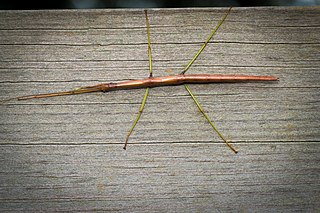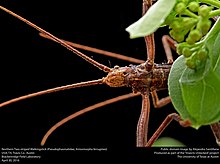
The Phasmatodea are an order of insects whose members are variously known as stick insects, stick-bugs, walking sticks, stick animals, or bug sticks. They are also occasionally referred to as Devil's darning needles, although this name is shared by both dragonflies and crane flies. They can be generally referred to as phasmatodeans, phasmids, or ghost insects, with phasmids in the family Phylliidae called leaf insects, leaf-bugs, walking leaves, or bug leaves. The group's name is derived from the Ancient Greek φάσμα phasma, meaning an apparition or phantom, referring to their resemblance to vegetation while in fact being animals. Their natural camouflage makes them difficult for predators to detect; still, many species have one of several secondary lines of defense in the form of startle displays, spines or toxic secretions. Stick insects from the genera Phryganistria, Ctenomorpha, and Phobaeticus include the world's longest insects.

The curlew sandpiper is a small wader that breeds on the tundra of Arctic Siberia.

The striped possum or common striped possum is a member of the marsupial family Petauridae. It is found mainly in New Guinea. The species is black with three white stripes running head to tail, and its head has white stripes that form a 'Y' shape. It is closely related to the sugar glider, and is similar in appearance.

The common walkingstick or northern walkingstick is a species of phasmid or stick insect found across North America. The average length of this species is 75mm (3 in) for males and 95mm (3.7 in) for females.

Anisomorpha is a genus of walking stick insect capable of secreting a substance from glands on the metathorax that can cause an intense burning irritation of the eyes and mouth of potential predators on contact. In some cases, this causes temporary blindness. Species are found throughout the mainland Central, northern South America, and the southeastern United States. The adult female is larger than the male in length and width. There are currently four accepted species in this genus, and all are wingless.

Anisomorpha buprestoides, the southern two-striped walkingstick, devil rider, or musk mare, is a stick insect which occurs throughout the southeastern United States.

Miogryllus saussurei is a cricket in the genus Miogryllus, in the subfamily Gryllinae. A common name for Miogryllus saussurei is "eastern striped cricket".

Diapheromera arizonensis, the Arizona walkingstick, is a species of walkingstick in the family Diapheromeridae. It is found in North America.

Parabacillus hesperus, the western short-horn walkingstick, is a species of walkingstick in the family Heteronemiidae. It is found in North America. This species is found in dry, arid in the summer and fall. Their diet consists of various scrub and grassland plants. Through an adaptation called "crypsis," it blends in so perfectly with its natural habitat that it often goes completely undetected by would-be predators.

Peridea ferruginea, the chocolate prominent, is a species of prominent moth in the family Notodontidae. It was described by Alpheus Spring Packard in 1864 and is found in North America. In 2018, Miller et al. distinguished Peridea bordeloni, whose larvae specialize on river birch Betula nigra, as a separate species, though P. bordeloni has previously been identified as P. ferruginea.

Diapheromera is a genus of stick insects in the family Diapheromeridae. There are about 14 described species in Diapheromera.

Parabacillus is a genus of short-horn walkingsticks in the family Heteronemiidae. There are at least three described species in Parabacillus.

Heteronemiidae is a family of walkingsticks in the order Phasmatodea. There are about 14 genera and at least 80 described species in Heteronemiidae.

Nephrotoma ferruginea is a species of large crane fly in the family Tipulidae.

Chortophaga viridifasciata, the green-striped grasshopper, is a species of band-winged grasshopper in the family Acrididae. It is found in Central America and North America, ranging from British Columbia to the Gulf of Mexico, south to Costa Rica.
Timema ritense, the Santa Rita timema, is a species of walkingstick in the family Timematidae. It is found in North America. The species was originally spelled "ritensis", but this spelling did not match the gender of the genus Timema, and therefore has undergone a mandatory change following ICZN Article 31.2.

Pseudosermyle strigata, the striped walkingstick, is a species of walkingstick in the family Diapheromeridae. It is found in North America.

Pseudosermyle is a genus of walkingsticks in the family Diapheromeridae. There are more than 20 described species in Pseudosermyle.

Diapheromerini is a tribe of walkingsticks in the family Diapheromeridae. There are at least 30 genera Diapheromerini.
Anisacanthidae is a family of walkingsticks in the order Phasmatodea. There are about 10 genera and at least 30 described species in Anisacanthidae.

















